
India is a land where music is more than just sound—it’s a reflection of culture, tradition, and history. Have you ever wondered how the vibrant rhythms of Indian villages evolved into the diverse music styles we hear today? From the mystical tunes of ancient India to the lively beats that accompany festivals and daily life, Indian folk music offers a fascinating journey through time.
Rooted in local traditions and shaped by nature, festivals, and stories passed down through generations, these melodies have preserved the soul of communities for centuries. Whether it’s the rustic charm of a Rajasthani folk song, the spiritual resonance of a devotional tune, or the storytelling rhythms of Bengal’s Baul singers, each style carries a piece of India’s rich musical heritage.
In this blog, we’ll explore the origins, instruments, cultural significance, and evolution of Indian folk music. You’ll discover how ancient forms of Indian music influenced today’s Indian music styles, the instruments that brought these tunes to life, and how modern adaptations continue to keep this tradition alive. So, if you’re curious about the history of music in India and eager to dive into its cultural tapestry, let’s embark on this melodious journey together.
1. Origins of Indian Folk Music
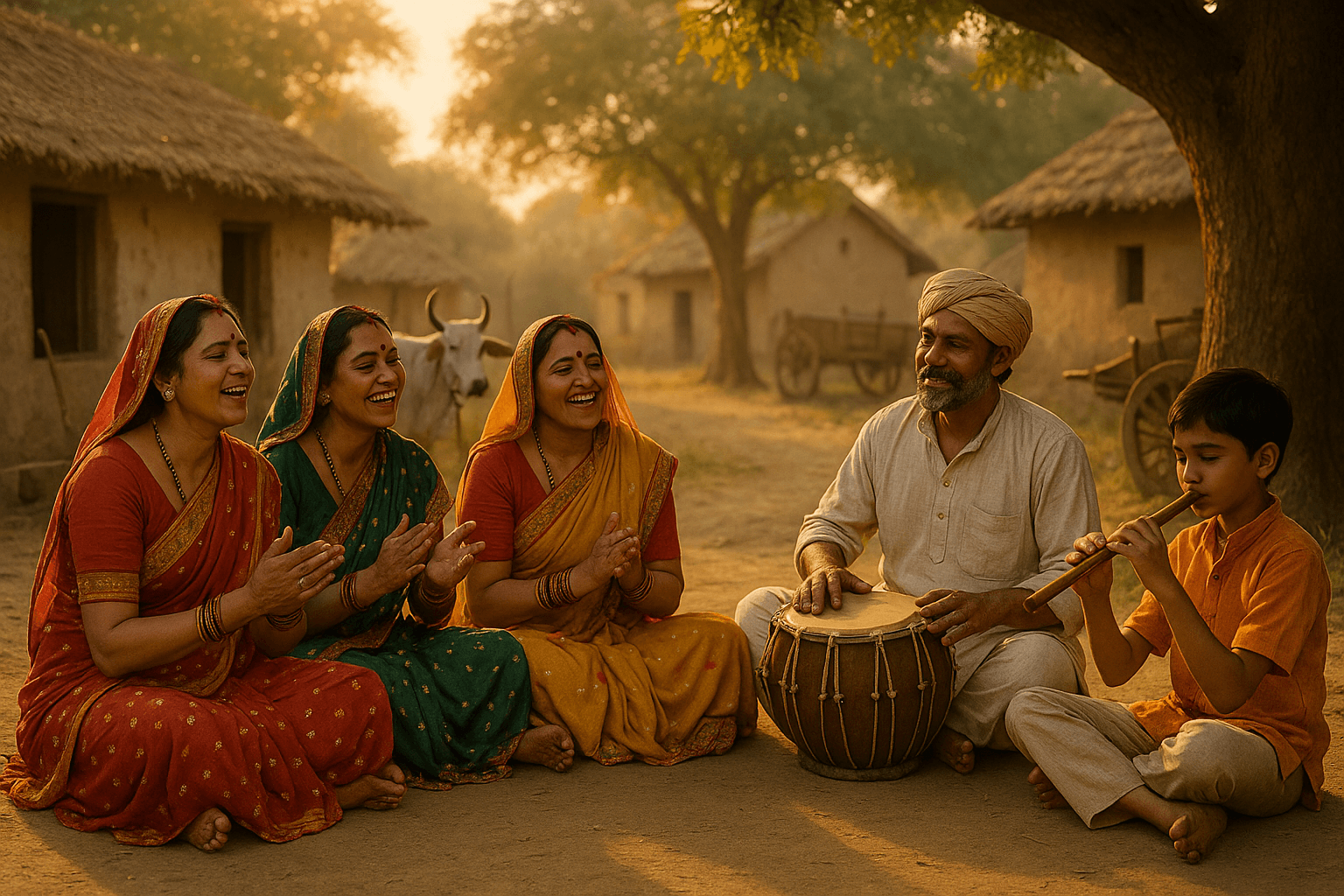 Indian folk music has its roots deeply embedded in the daily lives and traditions of rural communities across the subcontinent. Unlike the formal structures of classical music, folk music is spontaneous, evolving with the rhythms of nature and the seasons.
Indian folk music has its roots deeply embedded in the daily lives and traditions of rural communities across the subcontinent. Unlike the formal structures of classical music, folk music is spontaneous, evolving with the rhythms of nature and the seasons.
Regional Roots: Understanding Local Traditions
Each region in India boasts its own unique folk traditions, influenced by local customs, languages, and lifestyles. For instance, the Baul songs of Bengal reflect the mysticism and simplicity of rural life, while the Lavani of Maharashtra captures the vibrant energy of folk theatre.
Influence of Nature and Daily Life on Folk Songs
Nature has always been a profound inspiration for Indian folk music. Songs often narrate tales of harvests, monsoons, and the changing seasons, serving as both entertainment and a means of preserving communal history.
Early Instruments Used in Folk Music
Traditional instruments such as the dholak, ektara, and flute have been integral to folk performances. These instruments are not just musical tools but also carry cultural significance, often handcrafted using locally available materials.
Role of Oral Tradition in Preserving Songs
The oral tradition has played a crucial role in the transmission of folk music. Generations have passed down songs through storytelling, ensuring that the essence of regional cultures is preserved and celebrated.
2. Major Folk Music Styles Across India
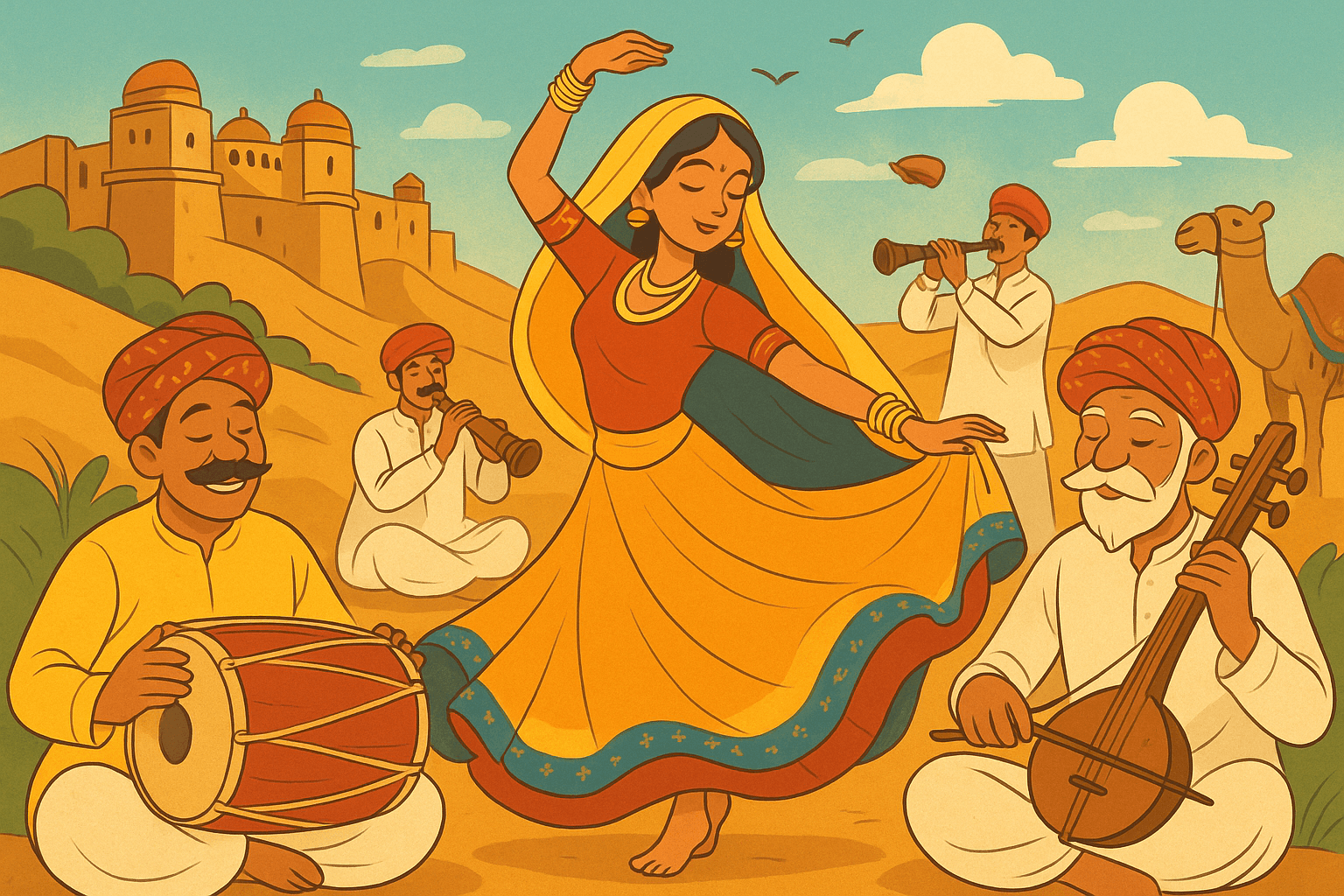 India’s diversity is mirrored beautifully in its folk music, with each region offering a unique sound, rhythm, and story. Have you ever noticed how different a celebration in Punjab feels compared to a festival in Bengal or Maharashtra? That’s the magic of Indian music styles at work—each carrying the cultural identity of its people.
India’s diversity is mirrored beautifully in its folk music, with each region offering a unique sound, rhythm, and story. Have you ever noticed how different a celebration in Punjab feels compared to a festival in Bengal or Maharashtra? That’s the magic of Indian music styles at work—each carrying the cultural identity of its people.
North Indian Folk Traditions
- Bhangra: Originating from Punjab, Bhangra is energetic, vibrant, and impossible not to dance to. Traditionally linked to harvest celebrations, it uses the dhol and chimta to create infectious rhythms.
- Rajasthani Folk Songs: From the haunting melodies of Maand to the lively tunes of Ghoomar, Rajasthan’s folk music reflects its desert landscapes and royal heritage.
- Bhakti Songs: Spiritual and devotional, these songs have been integral to temples and religious gatherings, connecting communities through traditional Indian music. You can also explore how these devotional styles relate to modern Hindustani singing techniques in courses like Online Hindustani Vocal Classes.
South Indian Folk Traditions
- Villu Paatu: A storytelling musical form from Tamil Nadu, combining narration, singing, and rhythm to convey folklore and moral tales.
- Dollu Kunitha: Karnataka’s drum dance form, often performed in vibrant troupes, showcases communal energy and celebration.
Eastern Indian Folk Styles
- Baul Songs: Mystical and soul-stirring, these songs from Bengal reflect philosophy, love, and devotion, often performed with minimal instruments.
- Chhau: A dramatic combination of dance, music, and storytelling, Chhau thrives in Odisha, West Bengal, and Jharkhand, narrating epics through vigorous movements and percussion.
Western Indian Folk
- Lavani: Maharashtra’s rhythmic and expressive music, traditionally performed with dance, is known for its fast tempo and captivating storytelling.
- Goan Folk Music: Influenced by Portuguese culture, these melodies combine Indian and Western elements, offering a unique musical experience.
By exploring these regional styles, you start to understand the forms of Indian music and how they capture the essence of local life, festivals, and social rituals. Each song tells a story, each rhythm evokes a mood, and together they form a rich mosaic of India’s cultural heritage.
3. Instruments and Rhythms in Folk Music
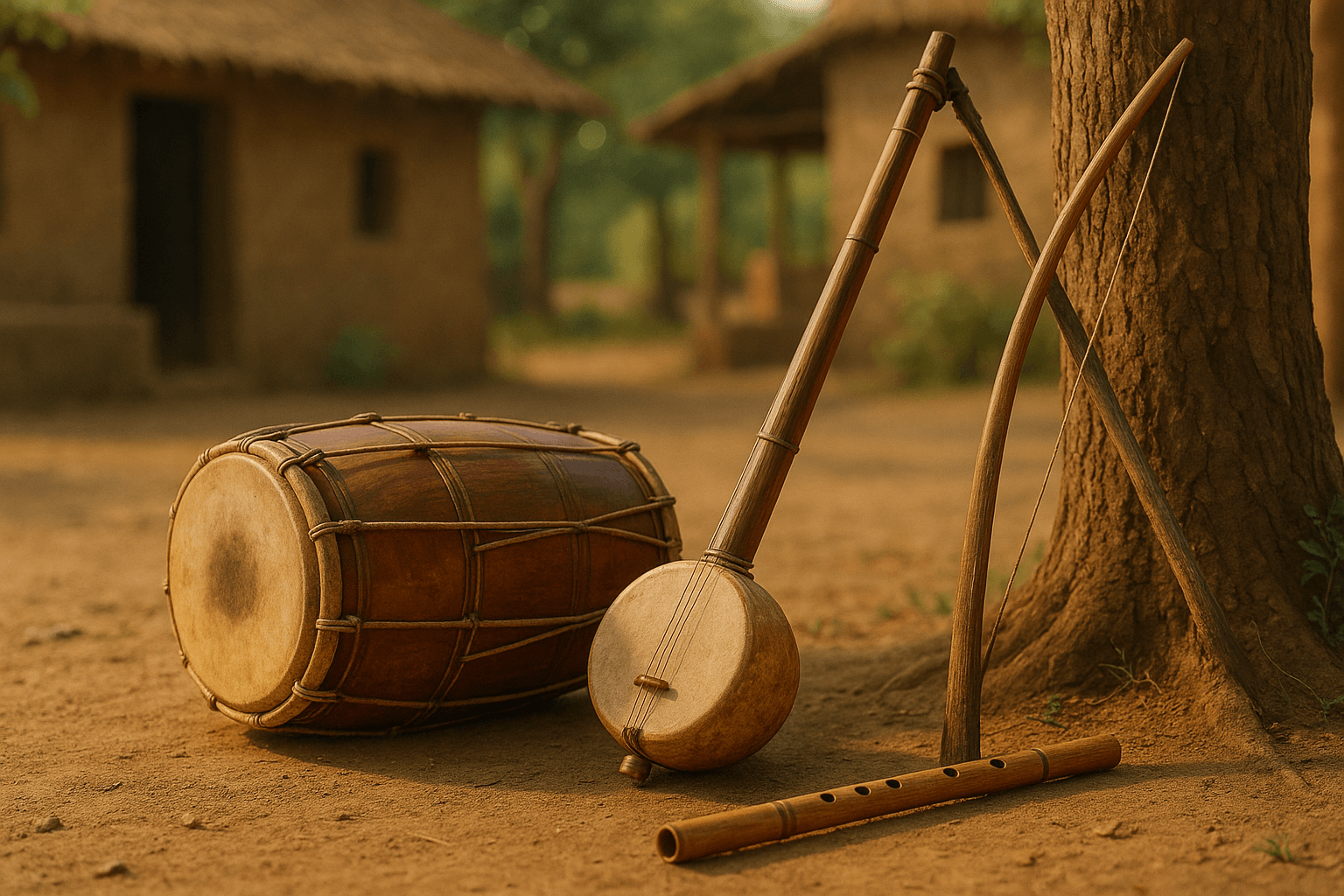 Have you ever wondered what gives Indian folk music its distinctive charm? Much of its magic comes from the instruments and rhythms that bring these songs to life. Unlike classical compositions, which often follow strict rules, folk music thrives on spontaneity and community energy.
Have you ever wondered what gives Indian folk music its distinctive charm? Much of its magic comes from the instruments and rhythms that bring these songs to life. Unlike classical compositions, which often follow strict rules, folk music thrives on spontaneity and community energy.
Traditional Instruments Across Regions
- Dhol and Dholak: These double-headed drums are central to North Indian and Punjabi folk traditions. Their pulsating beats drive dances like Bhangra and Garba.
- Ektara: A one-stringed instrument, commonly used by Baul singers in Bengal, producing hypnotic melodies that complement storytelling.
- Flute and Shehnai: These wind instruments add emotional depth, often mimicking the tunes of nature, from flowing rivers to chirping birds.
- Villu Paatu Bow: South India’s unique stringed instrument is used to narrate tales, blending rhythm with melodic storytelling.
Regional Rhythms and Their Influence
- Every region in India has distinct rhythmic patterns that reflect local culture and lifestyle. For example, the fast-paced beats of Maharashtra’s Lavani differ greatly from the slower, meditative rhythms of Tamil Nadu’s Villu Paatu.
- These rhythms influence how folk singers modulate their voices, creating a unique Indian tune that resonates with the community.
Connection with Classical Music
Interestingly, many folk instruments and rhythms have influenced Indian classical music over time. The simplicity of a dholak pattern or the melodic phrasing of an ektara often finds echoes in Hindustani and Carnatic vocal practices. If you’re interested in exploring how these traditional rhythms translate into formal training, platforms like Online Carnatic Vocal Classes offer structured lessons that bridge folk and classical styles.
Why Instruments Matter
Instruments are more than tools—they are storytellers. Each note, beat, and melody carries cultural memory, making folk music not just entertainment but a living archive of India’s traditional Indian music.
4. Folk Music and Cultural Identity
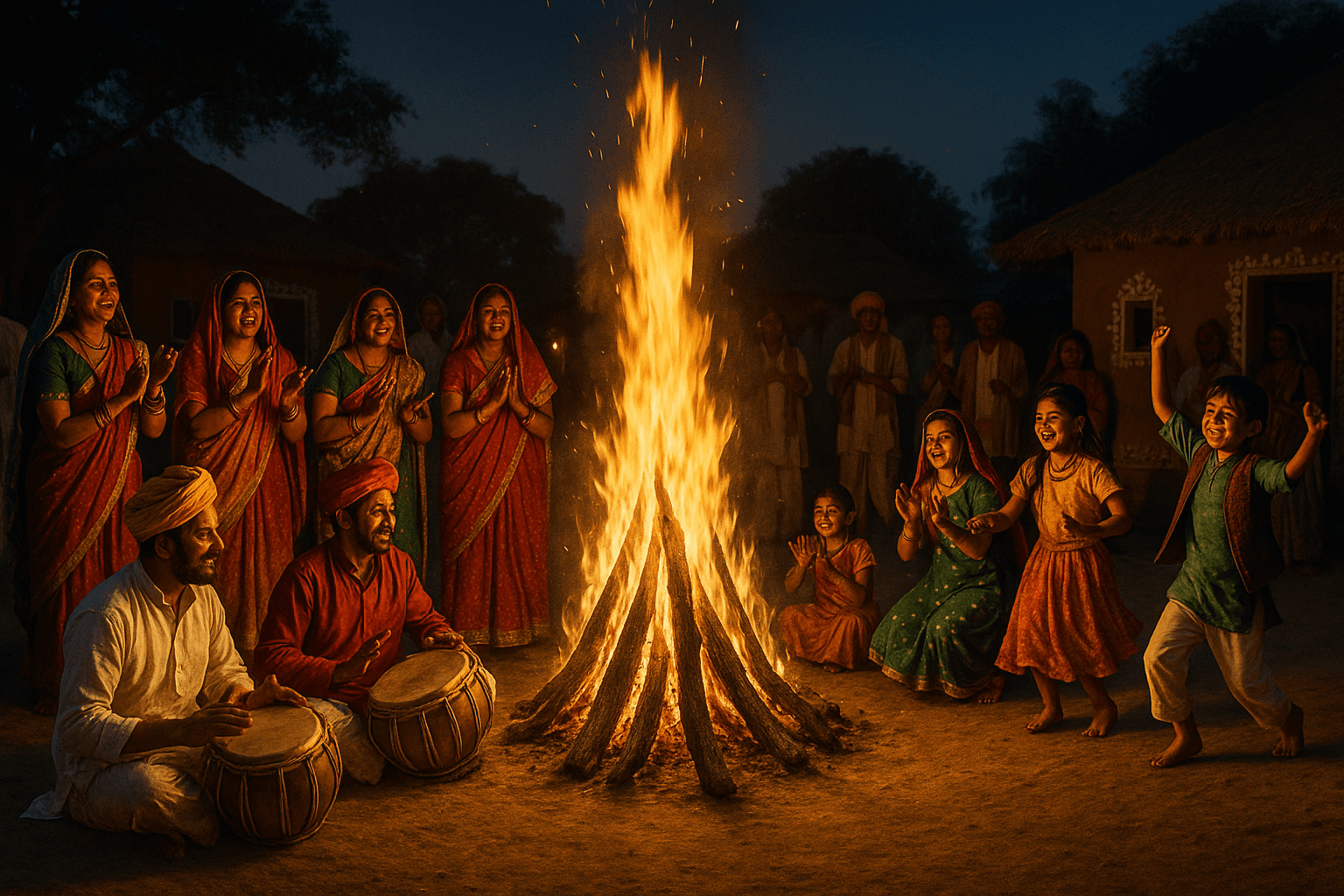 Have you ever felt how music can instantly transport you to a place, a time, or even a celebration? That’s exactly what cultural music in India does. Folk music is more than just melodies—it’s a reflection of communities, beliefs, and shared experiences.
Have you ever felt how music can instantly transport you to a place, a time, or even a celebration? That’s exactly what cultural music in India does. Folk music is more than just melodies—it’s a reflection of communities, beliefs, and shared experiences.
Music as a Social Connector
- Folk songs often accompany festivals, harvests, weddings, and religious rituals, bringing people together through shared rhythm and storytelling.
- These melodies serve as a communal memory, keeping local legends, historical events, and social values alive for generations.
Storytelling Through Folk Tunes
- Many folk songs are narrative in nature, recounting tales of heroes, love, devotion, or moral lessons.
- For example, Baul songs from Bengal blend philosophy and storytelling, while Lavani from Maharashtra uses expressive dance and music to narrate vibrant tales.
Spiritual and Religious Significance
- Folk music frequently intersects with spirituality. Bhakti songs and devotional tunes create a bridge between everyday life and sacred traditions.
- Exploring these roots can enhance your understanding of forms of Indian music and their connection to heritage. For those eager to experience and learn firsthand, Book a Free Trial Class to explore the nuances of traditional and devotional music in a structured setting.
Identity and Preservation
- Folk music is a cultural fingerprint. Through regional styles, instruments, and rhythms, it preserves identity while evolving with contemporary influences.
- By understanding these musical forms, you not only appreciate the art but also the communities and histories they represent.
Folk music is more than sound—it’s a living story of India’s diverse cultural identity, passed down from generation to generation, preserving the history of music of India in every note.
5. Evolution Through Historical Changes
 Have you ever wondered how centuries of social, political, and cultural shifts shaped the folk music we enjoy today? The journey of Indian music is as dynamic as the country itself, reflecting influences from kings, colonizers, and modern urban life.
Have you ever wondered how centuries of social, political, and cultural shifts shaped the folk music we enjoy today? The journey of Indian music is as dynamic as the country itself, reflecting influences from kings, colonizers, and modern urban life.
Royal Patronage and Regional Flourishing
- Many folk traditions flourished under the support of regional kingdoms. Rajasthani songs and dances, for instance, were often performed in palaces, blending local narratives with regal flair.
- Royal patronage not only preserved these melodies but also allowed for the development of intricate rhythms and instruments, laying the foundation for future forms of Indian music.
Influence of Colonialism
-
Colonial rule introduced new instruments, performance contexts, and even music education systems. While some folk traditions faced decline, others adapted by incorporating elements from European music, creating unique hybrid styles.
-
This period also sparked the documentation of folk music, ensuring that history of music of India was preserved for future generations.
Transition into Modern India
- Urbanization and media exposure transformed folk music into accessible forms for a wider audience. Many traditional tunes found their way into films, television, and recordings, connecting rural roots with city life.
- Today, the evolution continues as folk styles inspire contemporary music genres, blending age-old melodies with modern rhythms, proving that Indian music styles are both timeless and adaptable.
Why Understanding Evolution Matters
- By tracing the historical changes in folk music, you gain insight into the resilience and creativity of communities. It also allows us to appreciate the depth behind each performance, whether it’s a village celebration or a modern reinterpretation on stage.
Folk music is not just a relic of the past—it’s a living tradition, evolving yet preserving the essence of traditional Indian music for generations to come.
6. Fusion and Contemporary Folk Music
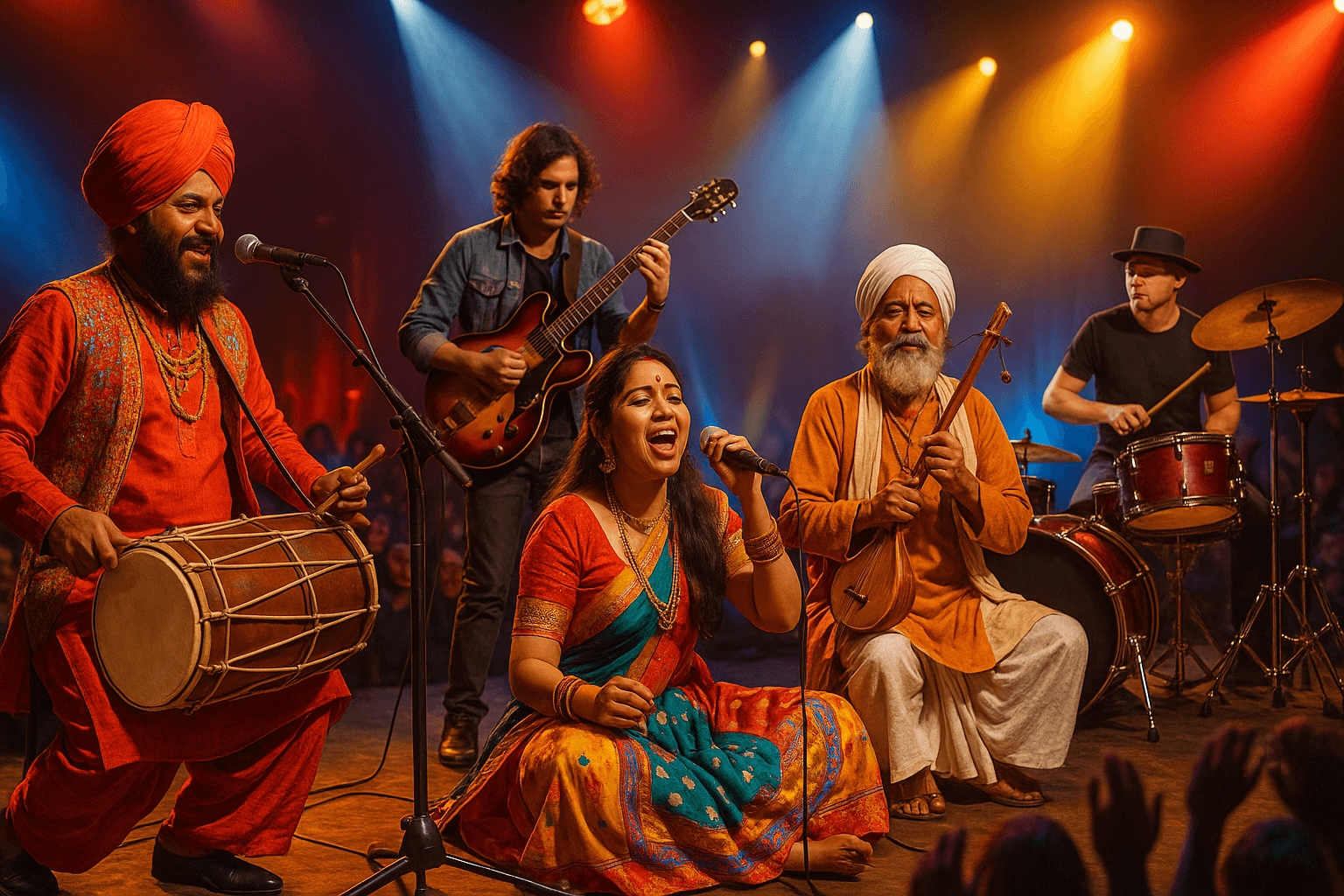 Have you noticed how some traditional tunes suddenly feel fresh when combined with modern beats? This is the magic of fusion and contemporary Indian music, where folk traditions meet new-age experimentation to create sounds that resonate with today’s audience.
Have you noticed how some traditional tunes suddenly feel fresh when combined with modern beats? This is the magic of fusion and contemporary Indian music, where folk traditions meet new-age experimentation to create sounds that resonate with today’s audience.
Folk Meets Bollywood and Popular Music
- Many folk melodies have been adapted into Bollywood songs, making traditional rhythms more accessible to urban audiences.
- From Punjabi Bhangra beats in pop tracks to Rajasthani tunes in film scores, these adaptations preserve classical songs of India while reaching global listeners.
Revival Through Folk Fusion Artists
- Contemporary musicians and bands are blending folk with jazz, rock, and electronic music.
- Artists often incorporate instruments like the dhol, ektara, and flute into modern compositions, ensuring that Indian music styles remain relevant and dynamic.
Digital Platforms Promoting Folk Music
- Online platforms and streaming services have made it easier than ever to discover regional folk music from across India.
- From curated playlists to virtual workshops, digital access is helping preserve and popularize traditional Indian music for younger generations.
The Cultural Significance of Fusion
- Fusion isn’t just about music—it’s about storytelling, identity, and keeping heritage alive. By blending the old with the new, these adaptations invite listeners to explore the origins of Indian classical music and regional folk traditions.
- For those inspired to dive deeper, structured learning opportunities in Hindustani and Carnatic music can provide a deeper understanding of these roots, connecting you to the timeless essence of Indian melodies.
Fusion and contemporary interpretations prove that Indian folk music is not static—it’s an evolving, living art form that continues to inspire, entertain, and educate.
7. Learning and Experiencing Indian Folk Music
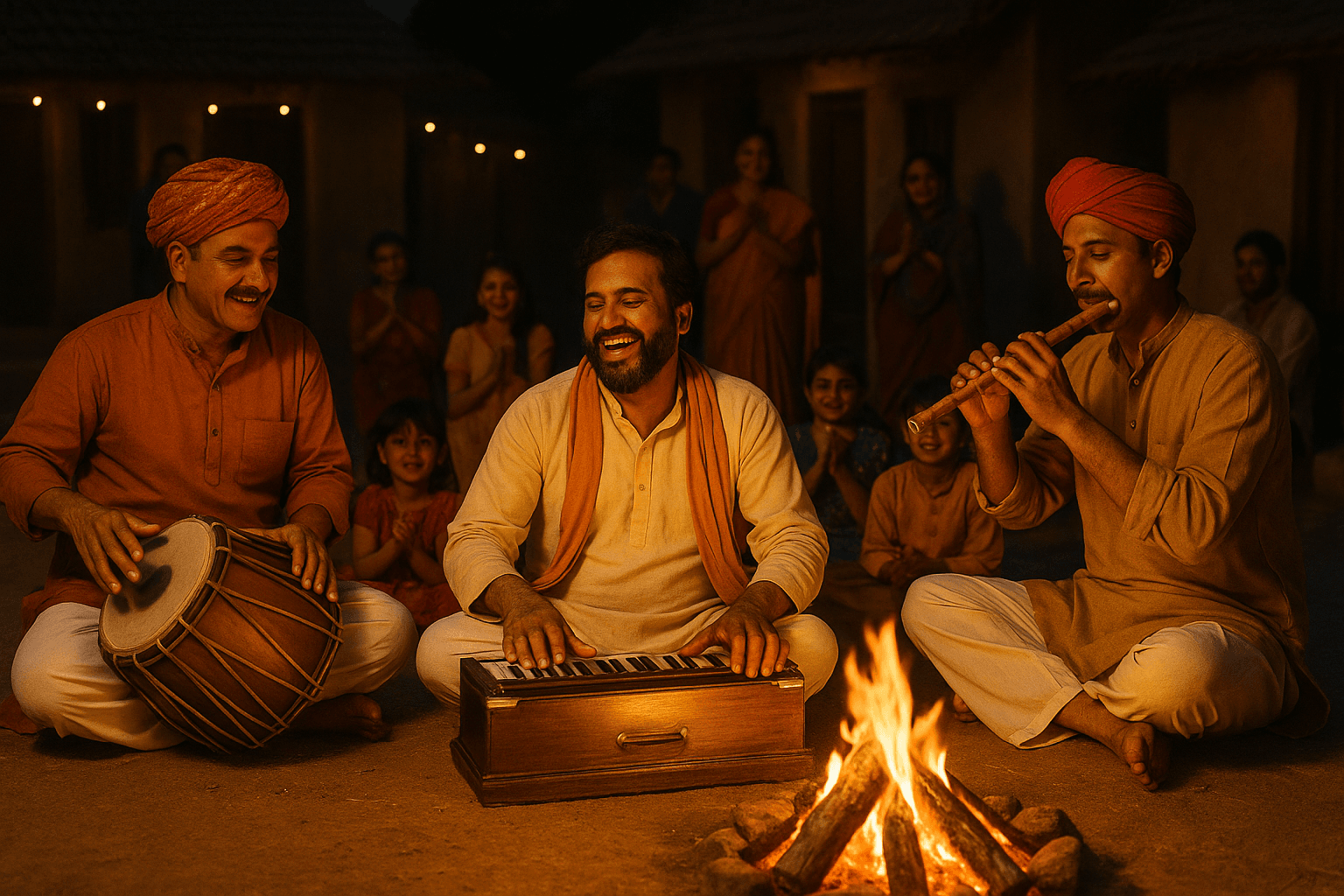 Have you ever wanted to not just listen to folk music but truly experience it? Engaging with Indian music firsthand allows you to connect with its rich history, cultural context, and emotional depth. Whether you’re a beginner or a seasoned enthusiast, there are many ways to dive into the vibrant world of folk music.
Have you ever wanted to not just listen to folk music but truly experience it? Engaging with Indian music firsthand allows you to connect with its rich history, cultural context, and emotional depth. Whether you’re a beginner or a seasoned enthusiast, there are many ways to dive into the vibrant world of folk music.
Opportunities to Learn Folk Instruments and Vocals
- Explore traditional instruments like the dholak, flute, and ektara through workshops or online lessons.
- Learn regional vocal styles, from devotional Bhakti songs to energetic Bhangra chants, which help you understand the nuances of forms of Indian music.
Online Classes and Structured Learning
- Modern technology has made it easier than ever to study folk music from anywhere in the world. Online platforms provide lessons that combine theory, practical training, and performance opportunities.
- Platforms like Online Hindustani Vocal Classes and Online Carnatic Vocal Classes offer structured courses where you can learn traditional techniques, scales, and improvisation.
Experiencing Folk Music Live
- Attending festivals, cultural events, or local performances can immerse you in the energy and authenticity of folk music.
- Participating in community celebrations or workshops provides a deeper understanding of traditional Indian music and its role in social and spiritual life.
Why Learning Folk Music Matters
- Engaging with folk music not only sharpens your musical skills but also connects you to India’s cultural heritage.
- By learning and performing these songs, you become part of a living tradition, preserving ancient rhythms, melodies, and stories for future generations.
Whether through instruments, vocals, or live experiences, exploring Indian folk music offers a unique way to appreciate the richness of cultural music in India while keeping its legacy alive.


 Indian folk music has its roots deeply embedded in the daily lives and traditions of rural communities across the subcontinent. Unlike the formal structures of classical music, folk music is spontaneous, evolving with the rhythms of nature and the seasons.
Indian folk music has its roots deeply embedded in the daily lives and traditions of rural communities across the subcontinent. Unlike the formal structures of classical music, folk music is spontaneous, evolving with the rhythms of nature and the seasons. India’s diversity is mirrored beautifully in its folk music, with each region offering a unique sound, rhythm, and story. Have you ever noticed how different a celebration in Punjab feels compared to a festival in Bengal or Maharashtra? That’s the magic of Indian music styles at work—each carrying the cultural identity of its people.
India’s diversity is mirrored beautifully in its folk music, with each region offering a unique sound, rhythm, and story. Have you ever noticed how different a celebration in Punjab feels compared to a festival in Bengal or Maharashtra? That’s the magic of Indian music styles at work—each carrying the cultural identity of its people. Have you ever wondered what gives Indian folk music its distinctive charm? Much of its magic comes from the instruments and rhythms that bring these songs to life. Unlike classical compositions, which often follow strict rules, folk music thrives on spontaneity and community energy.
Have you ever wondered what gives Indian folk music its distinctive charm? Much of its magic comes from the instruments and rhythms that bring these songs to life. Unlike classical compositions, which often follow strict rules, folk music thrives on spontaneity and community energy. Have you ever felt how music can instantly transport you to a place, a time, or even a celebration? That’s exactly what cultural music in India does. Folk music is more than just melodies—it’s a reflection of communities, beliefs, and shared experiences.
Have you ever felt how music can instantly transport you to a place, a time, or even a celebration? That’s exactly what cultural music in India does. Folk music is more than just melodies—it’s a reflection of communities, beliefs, and shared experiences. Have you ever wondered how centuries of social, political, and cultural shifts shaped the folk music we enjoy today? The journey of Indian music is as dynamic as the country itself, reflecting influences from kings, colonizers, and modern urban life.
Have you ever wondered how centuries of social, political, and cultural shifts shaped the folk music we enjoy today? The journey of Indian music is as dynamic as the country itself, reflecting influences from kings, colonizers, and modern urban life. Have you noticed how some traditional tunes suddenly feel fresh when combined with modern beats? This is the magic of fusion and contemporary Indian music, where folk traditions meet new-age experimentation to create sounds that resonate with today’s audience.
Have you noticed how some traditional tunes suddenly feel fresh when combined with modern beats? This is the magic of fusion and contemporary Indian music, where folk traditions meet new-age experimentation to create sounds that resonate with today’s audience. Have you ever wanted to not just listen to folk music but truly experience it? Engaging with Indian music firsthand allows you to connect with its rich history, cultural context, and emotional depth. Whether you’re a beginner or a seasoned enthusiast, there are many ways to dive into the vibrant world of folk music.
Have you ever wanted to not just listen to folk music but truly experience it? Engaging with Indian music firsthand allows you to connect with its rich history, cultural context, and emotional depth. Whether you’re a beginner or a seasoned enthusiast, there are many ways to dive into the vibrant world of folk music.